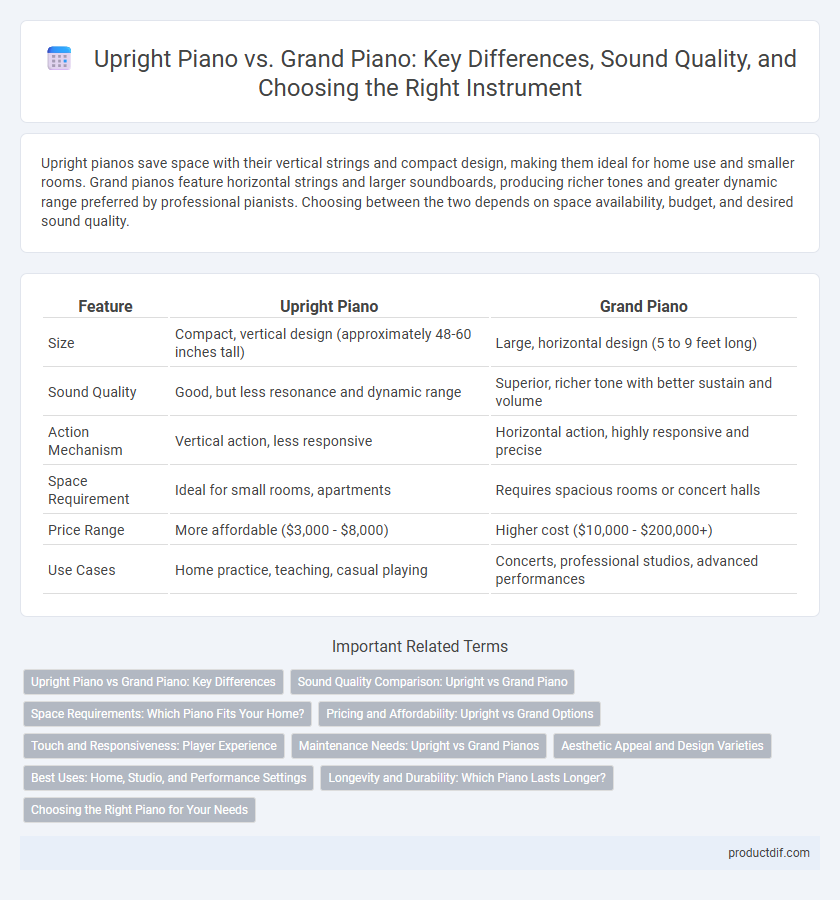Upright pianos save space with their vertical strings and compact design, making them ideal for home use and smaller rooms. Grand pianos feature horizontal strings and larger soundboards, producing richer tones and greater dynamic range preferred by professional pianists. Choosing between the two depends on space availability, budget, and desired sound quality.
Table of Comparison
| Feature | Upright Piano | Grand Piano |
|---|---|---|
| Size | Compact, vertical design (approximately 48-60 inches tall) | Large, horizontal design (5 to 9 feet long) |
| Sound Quality | Good, but less resonance and dynamic range | Superior, richer tone with better sustain and volume |
| Action Mechanism | Vertical action, less responsive | Horizontal action, highly responsive and precise |
| Space Requirement | Ideal for small rooms, apartments | Requires spacious rooms or concert halls |
| Price Range | More affordable ($3,000 - $8,000) | Higher cost ($10,000 - $200,000+) |
| Use Cases | Home practice, teaching, casual playing | Concerts, professional studios, advanced performances |
Upright Piano vs Grand Piano: Key Differences
Upright pianos have a vertical design that saves space, making them ideal for smaller rooms, while grand pianos feature a horizontal layout that enhances sound projection and resonance. The action mechanics differ, with grand pianos offering faster repetition and greater control due to their horizontal hammer alignment. Sound quality in grand pianos is generally richer and more dynamic, whereas upright pianos provide a more compact, affordable option without sacrificing essential tonal qualities.
Sound Quality Comparison: Upright vs Grand Piano
Grand pianos produce richer, more resonant sound due to their larger soundboard and longer strings, allowing greater dynamic range and tonal depth. Upright pianos offer a more compact sound with less sustain and volume, which can limit their expressive capabilities in comparison to grands. The action mechanism in grand pianos also enables faster repetition and more nuanced control, positively impacting sound quality.
Space Requirements: Which Piano Fits Your Home?
Upright pianos require significantly less floor space, making them ideal for smaller rooms or apartments where space is limited. Grand pianos need a spacious area for their extended strings and lid, often demanding at least 5 by 7 feet of floor area. Choosing between an upright and grand piano depends heavily on the available room size and desired acoustic presence in the home.
Pricing and Affordability: Upright vs Grand Options
Upright pianos generally offer greater affordability, with prices ranging from $3,000 to $8,000, making them accessible for beginners and home use. Grand pianos, priced between $7,000 and $100,000 or more, cater to professional musicians and serious enthusiasts due to their superior sound quality and craftsmanship. The significant price difference stems from construction complexity and materials, positioning upright pianos as budget-friendly while grands serve premium markets.
Touch and Responsiveness: Player Experience
Upright pianos offer a more compact action with slightly less key depth, resulting in a firmer touch and moderate responsiveness suited for smaller spaces. Grand pianos feature horizontal strings and a direct action mechanism, providing superior touch sensitivity and faster repetition, which enhances dynamic control and expressive playing. Pianists often prefer grand pianos for their nuanced response and greater control over tone and volume.
Maintenance Needs: Upright vs Grand Pianos
Upright pianos require more frequent tuning and regulation due to their vertical string and action design, which can be more susceptible to environmental changes like humidity and temperature fluctuations. Grand pianos, with their horizontal string layout and heavier, more robust construction, generally maintain tuning stability longer but demand specialized maintenance to address complex action mechanisms and occasional string replacement. Both types benefit from regular professional servicing to ensure optimal performance and longevity.
Aesthetic Appeal and Design Varieties
Upright pianos feature a compact, vertical design ideal for smaller spaces, often showcasing classic wood finishes and traditional styles that enhance cozy room aesthetics. Grand pianos offer a wide range of design varieties, including sleek modern and ornate handcrafted models, making them centerpieces in concert halls and luxury interiors due to their horizontal frame and open lid. Both instruments balance visual appeal with acoustic performance, but grand pianos are particularly prized for their elegant presence and intricate craftsmanship.
Best Uses: Home, Studio, and Performance Settings
Upright pianos offer compact design and affordability, making them ideal for home use and smaller studio spaces where space efficiency is crucial. Grand pianos deliver superior sound projection and dynamic range, preferred in professional studio environments and performance settings for their rich tonal quality. Musicians often choose upright pianos for practice and casual playing, while grand pianos are favored for concerts and advanced recording sessions.
Longevity and Durability: Which Piano Lasts Longer?
Upright pianos typically last 40 to 50 years with proper maintenance, while grand pianos can endure 60 to 80 years due to superior construction and high-quality materials. The robust frame and better soundboard design of grand pianos contribute to their enhanced durability and longer lifespan. Regular tuning, humidity control, and professional servicing are critical factors affecting the longevity of both upright and grand pianos.
Choosing the Right Piano for Your Needs
Selecting the right piano depends on space, budget, and sound preference; upright pianos offer compact design and affordability for casual players or limited spaces, while grand pianos provide superior sound quality and dynamic range ideal for performance and professional use. The vertical strings and action in upright pianos save floor space but may sacrifice some tonal depth compared to the horizontal string placement in grand pianos, which allows for richer resonance and greater control. Consider the primary use, room acoustics, and maintenance requirements to determine whether an upright or grand piano best suits your musical goals.
Upright piano vs Grand piano Infographic

 productdif.com
productdif.com